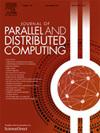支持隐私的学术证书认证和基于深度学习的学生成绩预测系统,使用超级账本区块链技术
IF 3.4
3区 计算机科学
Q1 COMPUTER SCIENCE, THEORY & METHODS
引用次数: 0
摘要
区块链系统不依赖于电子交易的信任,由于其不变性、透明度、分布式存储和分散控制等属性,它成为一种流行的技术。学生证书和技能验证在工作申请和其他目的中起着至关重要的作用。在传统的教育系统中,证书伪造是一个常见的问题,特别是在网络教育中。诸如颁发和验证学生证书以及高等教育或工作招聘的学生表现预测等过程通常是漫长而耗时的。将区块链集成到证书验证协议中提供了真实性,并大大缩短了处理时间。因此,本研究提出了一种基于安全隐私保护的新型学历证书认证系统(CertAuthSystem),用于对学生的学历证书进行验证。CertAuthSystem包含不同的实体,如Student、System、University、区块链和Company。大学向学生颁发证书,这些证书存储在区块链中,当学生申请工作/奖学金时,他/她将证书和blockID传送给组织,根据该组织进行验证。此外,学生的表现是由一个分类器称为深长短期记忆(DLSTM)预测。然后,考虑验证时间、内存、吞吐量和执行时间等指标,对CertAuthSystem的优越性进行了检验,在块大小为7的情况下,CertAuthSystem的值分别为53.412 ms、86.6 MB、94.876 Mbps和73.57 ms。最后,基于准确率、召回率和F度量等评价指标对DLSTM分类器进行预测分析,得到了90.77%、92.99%和91.86%的优值。本文章由计算机程序翻译,如有差异,请以英文原文为准。
Privacy-enabled academic certificate authentication and deep learning-based student performance prediction system using hyperledger blockchain technology
Blockchain systems do not rely on trust for electronic transactions and it emerged as a popular technology due to its attributes like immutability, transparency, distributed storage, and decentralized control. Student certificates and skill verification play crucial roles in job applications and other purposes. In traditional systems, certificate forgery is a common problem, especially in online education. Processes, such as issuing and verifying student certifications along with student performance prediction for higher education or job recruitment are often lengthy and time-consuming. Integrating blockchain into certificate verification protocols offers authenticity and significantly reduces processing times. Hence, this research introduced a novel secure privacy preservation-based academic certificate authentication system (CertAuthSystem) for verifying the academic certificates of students. The CertAuthSystem contains different entities, such as Student, System, University, Blockchain, and Company. The university issues certificates to students, which are stored in Blockchain, and when the student applies for a job/scholarship, he/she transmits the certificate and the blockID to the organization, based on which verification is performed. Moreover, the student’s performance is predicted by a classifier named Deep Long Short-Term Memory (DLSTM). Then, CertAuthSystem is examined for its superiority considering measures, like validation time, memory, throughput and execution time and has achieved values of 53.412 ms, 86.6 MB, 94.876 Mbps, and 73.57 ms, correspondingly for block size 7. Finally, the prediction analysis of the DLSTM classifier is done based on evaluation metrics, such as precision, recall and F measure, which attained superior values of 90.77 %, 92.99 %, and 91.86 %.
求助全文
通过发布文献求助,成功后即可免费获取论文全文。
去求助
来源期刊

Journal of Parallel and Distributed Computing
工程技术-计算机:理论方法
CiteScore
10.30
自引率
2.60%
发文量
172
审稿时长
12 months
期刊介绍:
This international journal is directed to researchers, engineers, educators, managers, programmers, and users of computers who have particular interests in parallel processing and/or distributed computing.
The Journal of Parallel and Distributed Computing publishes original research papers and timely review articles on the theory, design, evaluation, and use of parallel and/or distributed computing systems. The journal also features special issues on these topics; again covering the full range from the design to the use of our targeted systems.
 求助内容:
求助内容: 应助结果提醒方式:
应助结果提醒方式:


